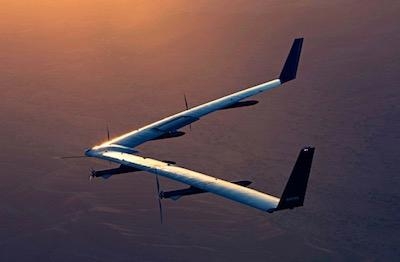Sat, Jul 01, 2017
The Aircraft Took Off, Flew And Landed Safely This Time Around
Facebook has completed the second flight of its Aquila drone it hopes to use to provide internet connectivity to remote areas of the world ... and this time the aircraft landed safely.

The 1 hour and 46 minute flight concluded with a smooth landing on the site prepared by the company at the Yuma Proving Ground in Arizona.
Writing on the Facebook blog, Martin Lois Gomez writes that the company learned some lessons from the first flight, which ended with the drone being damaged when it impacting terrain. Gomez writes that the Aquila was modified by:
- Adding “spoilers” to the wings, which help to increase drag and reduce lift during the landing approach
- Incorporating hundreds of sensors to gather new data
- Modifying the autopilot software
- Integrating new radios for the communication subsystem
- Applying a smoother finish on the plane
- Installing a horizontal propeller stopping mechanism to support a successful landing
The flight included lengthy test points at constant speed, heading, and altitude to measure the airplane’s drag. The data from these “trim shots,” as they’re called, will be used to refine aerodynamic models, which help in predicting the energy usage and thus optimize for battery and solar array size.
The aircraft's structure was also heavily instrumented with hundreds of sensors to collect data about how Aquila's shape responds to flight in real-time. These included hundreds of strain gauges and three-axis inertial measurement units (IMUs.) These tools serve to verify and refine our structural model, which predicts both the static shape of the airplane — designed to be very flexible to respond to wind gusts and maneuvers.
The aircraft landed autonomously on a 500-foot circle of level gravel about the consistency of rough sand. Aquila has no landing gear, per se, and instead lands on Kevlar pads glued to the bottom of the engine pods.
Now, the company will parse the data it collected on this flight to continue to refine and develop the aircraft for its intended use.
(Image courtesy of Facebook)
More News
Aero Linx: Model Aeronautical Association of Australia MAAA clubs are about fun flying, camaraderie and community. For over 75 years, the MAAA has been Australia’s largest fl>[...]
Touchdown Zone Lighting Two rows of transverse light bars located symmetrically about the runway centerline normally at 100 foot intervals. The basic system extends 3,000 feet alon>[...]
“Discovery and innovation are central to our mission at Virgin Galactic. We’re excited to build on our successful record of facilitating scientific experiments in subor>[...]
How To Get A Story On Aero-TV News/Feature Programming How do I submit a story idea or lead to Aero-TV? If you would like to submit a story idea or lead, please contact Jim Campbel>[...]
Student Pilot Reported That During Rotation, “All Of A Sudden The Back Of The Plane Kicked To The Right..." Analysis: The student pilot reported that during rotation, “>[...]
 ANN's Daily Aero-Linx (05.02.24)
ANN's Daily Aero-Linx (05.02.24) ANN's Daily Aero-Term (05.02.24): Touchdown Zone Lighting
ANN's Daily Aero-Term (05.02.24): Touchdown Zone Lighting Aero-News: Quote of the Day (05.02.24)
Aero-News: Quote of the Day (05.02.24) ANN FAQ: Contributing To Aero-TV
ANN FAQ: Contributing To Aero-TV NTSB Final Report: Cirrus Design Corp SR20
NTSB Final Report: Cirrus Design Corp SR20



